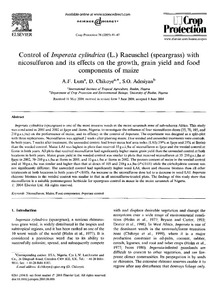| dc.contributor.author | Lum, F.A. |
| dc.contributor.author | Adesiyan, S. |
| dc.contributor.author | Chikoye, D. |
| dc.date.accessioned | 2019-12-04T11:23:37Z |
| dc.date.available | 2019-12-04T11:23:37Z |
| dc.date.issued | 2005-01 |
| dc.identifier.citation | Lum, A.F., Chikoye, D. & Adesiyan, S.O. (2005). Control of Imperata cylindrica (L.) Raeuschel (speargrass) with nicosulfuron and its effects on the growth, grain yield and food components of maize. Crop Protection, 24(1), 41-47. |
| dc.identifier.issn | 0261-2194 |
| dc.identifier.uri | https://hdl.handle.net/20.500.12478/4074 |
| dc.description.abstract | Imperata cylindrica (speargrass) is one of the most invasive weeds in the moist savannah zone of sub-saharan Africa. This study was conducted in 2001 and 2002 at Ijaye and Ilorin, Nigeria, to investigate the influence of four nicosulfuron doses (35, 70, 105, and 210 g a.i./ha) on the performance of maize, and its efficacy in the control of Imperata. The experiment was designed as a split-plot with three replications. Nicosulfuron was applied 2 weeks after planting maize. Hoe weeded and unweeded treatments were controls. In both years, 7 weeks after treatment, the unweeded control had lower maize leaf area index (LAI) (19% at Ijaye and 25% at Ilorin) than the weeded control. Maize LAI was highest in plots that received 35 g a.i./ha of nicosulfuron at Ijaye and the weeded control at Ilorin in both years. All plots that received nicosulfuron had significantly higher maize grain yield than the unweeded control at both locations in both years. Maize grain yield in the weeded control was similar to plots that received nicosulfuron at 35–210 g a.i./ha at Ijaye in 2002, 70–210 g a.i./ha at Ilorin in 2001, and 35 g a.i./ha at Ilorin in 2002. The protein content of maize in the weeded control and at 70 g a.i./ha was similar and higher than that at doses of 105 and 210 g a.i./ha while the carbohydrate content was not significantly different. The unweeded control had significantly higher weed LAI, shoot and rhizome biomass than all other treatments at both locations in both years . An increase in the nicosulfuron dose led to a decrease in weed LAI. Imperata rhizome biomass in the weeded control was similar to that in all nicosulfuron-treated plots. The findings of this study show that nicosulfuron is a suitable postemergence herbicide for speargrass control in maize in the moist savannah of Nigeria. |
| dc.language.iso | en |
| dc.subject | Nicosulfuron |
| dc.subject | Maize |
| dc.subject | Imperata |
| dc.title | Control of Imperata cylindrica (L.) Raeuschel (speargrass) with nicosulfuron and its effects on the growth, grain yield and food components of maize |
| dc.type | Journal Article |
| dc.description.version | Peer Review |
| cg.contributor.crp | Maize |
| cg.contributor.affiliation | International Institute of Tropical Agriculture |
| cg.contributor.affiliation | University of Ibadan |
| cg.coverage.region | Africa |
| cg.coverage.region | West Africa |
| cg.coverage.country | Nigeria |
| cg.isijournal | ISI Journal |
| cg.authorship.types | CGIAR and developing country institute |
| cg.iitasubject | Maize |
| cg.iitasubject | Plant Production |
| cg.accessibilitystatus | Limited Access |
| local.dspaceid | 99360 |
| cg.identifier.doi | https://doi.org/10.1016/j.cropro.2004.06.006 |

